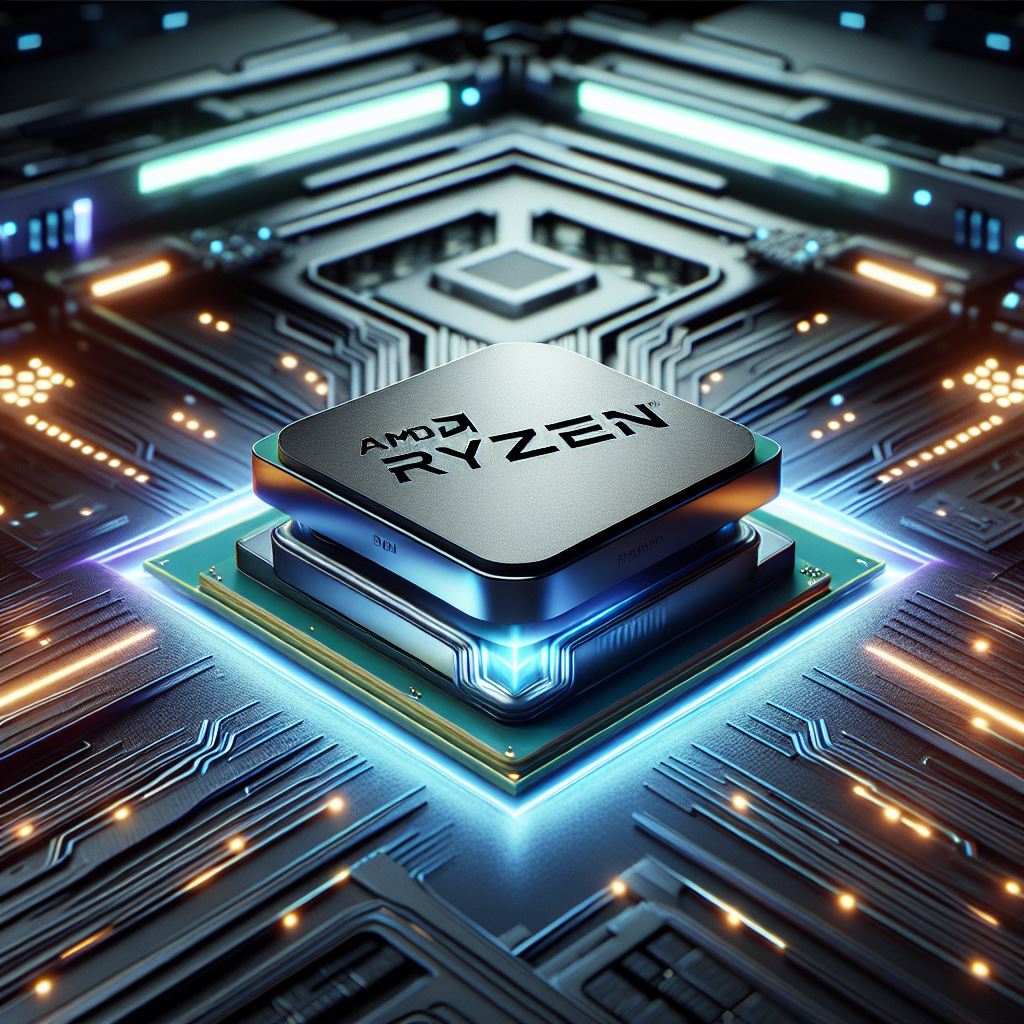AMD Ryzen 7 7800X3D (2025): The Reigning Champion of Gaming Performance?
In the ever-evolving landscape of PC gaming, where frame rates are king and immersion is paramount, enthusiasts constantly seek the bleeding edge – the component that unlocks the true potential of their graphics card and delivers the smoothest, most responsive experience imaginable. As we navigate 2025, standing tall atop the peak of gaming-focused CPU performance is the AMD Ryzen 7 7800X3D. This processor isn’t just another iteration; it represents the culmination of AMD’s architectural prowess and a laser-focus on solving one of gaming’s most persistent bottlenecks: CPU latency. Highly anticipated since its announcement and now available to power the most demanding gaming rigs, the 7800X3D leverages the refined power of second-generation AMD 3D V-Cache™ technology, establishing itself not merely as a competitor, but as the definitive 8-core processor designed explicitly for gamers who refuse to compromise. Forget incremental upgrades; this is about achieving a tangible leap in fluidity and performance where it counts the most.
Decoding the Magic: The Second-Generation 3D V-Cache Revolution
To truly appreciate the 7800X3D, one must understand the groundbreaking technology at its heart. Traditional CPUs rely on multiple levels of cache (L1, L2, L3) – small pools of ultra-fast memory sitting close to the processing cores – to store frequently accessed data and instructions, preventing the cores from having to wait for slower system RAM. However, even the largest traditional L3 caches can become overwhelmed by the complex demands of modern games, leading to latency spikes and limiting peak performance, especially at lower resolutions or in CPU-intensive scenarios.
AMD’s revolutionary answer was 3D V-Cache™: vertically stacking an additional, massive L3 cache die directly on top of the core complex die (CCD). This dramatically increased the amount of L3 cache available without significantly increasing the physical footprint on the motherboard. The Ryzen 7 7800X3D boasts the second generation of this technology, bringing crucial refinements. Key among these is an “inverted” 3D V-Cache stack. Unlike the first generation where the cache sat atop the cores, this design cleverly places the 64MB L3 cache die underneath the core complex die.
Insider Insight: This structural inversion is a masterstroke for thermal management. By positioning the heat-generating cores closer to the integrated heat spreader (IHS) and the CPU cooler, thermal transfer is significantly improved. This enhanced thermal headroom is precisely what allows the Zen 4 cores in the 7800X3D to reach and sustain higher boost clocks (up to 5.0 GHz) compared to its first-generation predecessors like the 5800X3D, all while operating within manageable thermal limits. It directly translates to more performance, more consistently. The total L3 cache pool swells to an enormous 96MB (32MB standard L3 on the CCD + 64MB of stacked 3D V-Cache), creating a vast reservoir for game data and dramatically reducing the need for the CPU to fetch information from slower system memory, thereby slashing latency and boosting frame rates.
Architectural Prowess and Platform Synergy: The Zen 4 Foundation
Beneath the revolutionary cache lies the formidable Zen 4 architecture. The 7800X3D wields 8 high-performance cores and 16 threads, providing a potent blend of single-threaded speed crucial for many games and robust multi-threaded capability for background tasks, streaming, or even light productivity. These cores operate at a respectable 4.2 GHz base clock, but more importantly, can intelligently ramp up to 5.0 GHz via AMD’s Precision Boost 2 algorithm under optimal conditions – conditions made more achievable thanks to the improved thermal design.
This powerhouse CPU slots into the modern AM5 socket (LGA1718), a shift from AMD’s previous PGA sockets, offering better pin durability and paving the way for future technologies. Compatibility is broad, spanning enthusiast-grade X870E and X670E chipsets (offering maximum PCIe 5.0 connectivity), mainstream X870 and X670, and capable B650E and B650 motherboards. This provides flexibility in building a system around your budget and needs.
Platform Synergy Secret: To truly unleash the 7800X3D, pairing it with the right components is key. While it supports standard DDR5 memory (up to JEDEC 5200/5600 MHz), Zen 4 thrives on high-speed RAM. Utilizing kits rated for 6000MHz or even slightly higher, especially those featuring AMD EXPO™ (Extended Profiles for Overclocking) technology for easy one-click memory overclocking in the BIOS, provides a noticeable uplift by ensuring the cores are constantly fed with data, complementing the massive L3 cache. Furthermore, leveraging the PCIe 5.0 support offered by AM5 motherboards (particularly abundant on X870E/X670E) for both the primary graphics card slot and potentially ultra-fast NVMe SSDs ensures your entire platform is ready for the next generation of bandwidth-hungry components, making this a truly future-proof investment.
The 7800X3D carries a TDP (Thermal Design Power) of 120W, with a maximum package power tracking (PPT) limit of around 162W under full load. While efficient for its performance class, this necessitates robust cooling – a high-end air cooler or, ideally, a 240mm or larger All-In-One (AIO) liquid cooler is strongly recommended to allow the chip to consistently hit its maximum boost clocks. It also features integrated AMD Radeon graphics, primarily useful for basic display output or troubleshooting, freeing you from needing a discrete GPU just to get a system running.
Gaming Supremacy: Where the 7800X3D Truly Shines
Let’s be unequivocal: the Ryzen 7 7800X3D was conceived, designed, and optimized with one primary goal – to deliver the absolute best gaming performance possible within an 8-core CPU package. The massive 96MB L3 cache acts like a turbocharger specifically for games. By drastically reducing the time the CPU cores spend waiting for data, it alleviates CPU bottlenecks, leading to significantly higher average frame rates, and perhaps more importantly, much smoother frame times (often measured as 1% lows). This translates to a visibly more fluid and responsive experience, especially noticeable when aiming for high refresh rates (144Hz, 240Hz, or beyond) or playing CPU-intensive titles like large-scale strategy games (Civilization, Total War), complex simulations (Microsoft Flight Simulator), or certain open-world RPGs with many interacting systems. Even at higher resolutions like 1440p or 4K where the GPU typically becomes the primary bottleneck, the 7800X3D ensures your expensive graphics card is fed data as quickly as possible, maximizing its potential and often providing higher minimum frame rates than competing CPUs.
Unlocking the Beast: “Insider” Tuning & Optimization Secrets
While previous generations of X3D chips had certain overclocking limitations, AMD has fully unleashed the 7800X3D. It features an unlocked multiplier and supports BCLK adjustments, offering traditional overclocking avenues for hardcore enthusiasts willing to push the limits.
The Smarter Path: However, the real “insider” secret for maximizing performance on the 7800X3D often lies not in complex manual overclocking, but in intelligently utilizing AMD’s built-in tools: Precision Boost Overdrive (PBO) and Curve Optimizer (CO). PBO allows the CPU to boost higher and longer, provided thermal and power limits allow. Curve Optimizer enables fine-grained, per-core undervolting. By carefully tuning the Curve Optimizer (finding the lowest stable negative offset for each core), you reduce voltage and heat generation without sacrificing performance. This lower heat output gives PBO more headroom to sustain higher boost clocks for longer durations across more cores. It’s a synergistic approach that leverages the chip’s efficiency and the improved thermal design, often yielding performance very close to, or sometimes even exceeding, manual overclocks but with potentially better stability and lower power draw. Remember that silicon quality varies (“silicon lottery”), so the maximum stable CO offset will differ from chip to chip. Also, crucially, keeping your motherboard BIOS updated is essential. AMD frequently releases AGESA (AMD Generic Encapsulated Software Architecture) updates bundled in BIOS releases, which often include significant performance tuning, stability enhancements, and improved compatibility specifically for Ryzen processors and their boosting algorithms.
How it Stacks Up: Facing the Competition
The 7800X3D doesn’t exist in a vacuum. Here’s how it compares:
- vs. Intel Core i9 (13th/14th Gen, e.g., 13900K/14900K): In gaming benchmarks, the 7800X3D consistently demonstrates a significant advantage, often averaging around 10-15% higher frame rates. While the Intel chips, with their higher core counts (mixing Performance-cores and Efficient-cores), typically pull ahead in heavily multi-threaded productivity workloads like video rendering or complex compilation, the 7800X3D remains the clear winner for pure gaming focus.
- vs. Intel Core Ultra 9 (Arrow Lake, e.g., 285K): Against Intel’s newer architecture, the 7800X3D’s gaming prowess, fueled by its massive cache, remains dominant, often showing leads potentially exceeding 30% in CPU-bound gaming scenarios. Again, the Intel chip might offer compelling performance-per-watt or specific advantages in AI or creation tasks, but for gaming, the 7800X3D leads significantly.
- vs. AMD Ryzen 9 7950X3D: This is a nuanced comparison. The 16-core 7950X3D splits its cores into two 8-core CCDs, only one of which has the 3D V-Cache. While powerful, this can sometimes lead to game scheduling needing optimization or slightly lower performance than the 7800X3D where all 8 cores benefit directly from the massive cache pool. Consequently, the 7800X3D often delivers around 5-8% better gaming performance and a simpler, more consistently optimized gaming experience. For users whose primary focus is productivity with gaming as a secondary concern, the 7950X3D’s 16 cores offer more raw multi-threaded power.
- vs. Standard Ryzen 7 (e.g., 7700X): Compared to its non-X3D siblings, the 7800X3D offers a substantial leap in gaming performance purely due to the 3D V-Cache, often delivering 20-30% or more uplift in CPU-limited gaming scenarios.
Is the Ultimate Gaming CPU Right for You?
Priced around $469 USD at launch, the Ryzen 7 7800X3D represents a premium investment targeted squarely at performance enthusiasts. It’s not the budget option, but rather the component you build a high-end gaming rig around. Remember the need for robust cooling – skimping here will prevent the chip from reaching its full potential. Overclocking, while fully supported, can be complex for newcomers, though PBO and Curve Optimizer offer a more accessible route to enhanced performance. If your primary use case involves heavy content creation, video editing, or scientific computing, a higher core count CPU (like the Ryzen 9 7950X or an Intel Core i9) might be more suitable. But if your machine’s raison d’être is gaming – achieving the highest possible frame rates, maximizing the potential of a powerful GPU, and enjoying the smoothest possible experience – the 7800X3D demands serious consideration.
The Final Verdict: The Gamer’s Undisputed Choice
The AMD Ryzen 7 7800X3D (2025) stands as a testament to AMD’s engineering focus on tangible gaming benefits. By refining its revolutionary 3D V-Cache technology and pairing it with the efficient Zen 4 architecture on the flexible AM5 platform, AMD has delivered what is arguably the fastest, most effective pure gaming processor available in its class. It eliminates CPU bottlenecks and lets your graphics card stretch its legs like never before. For the dedicated gamer building a high-performance rig in 2025, the Ryzen 7 7800X3D isn’t just an option; it’s a contender.



